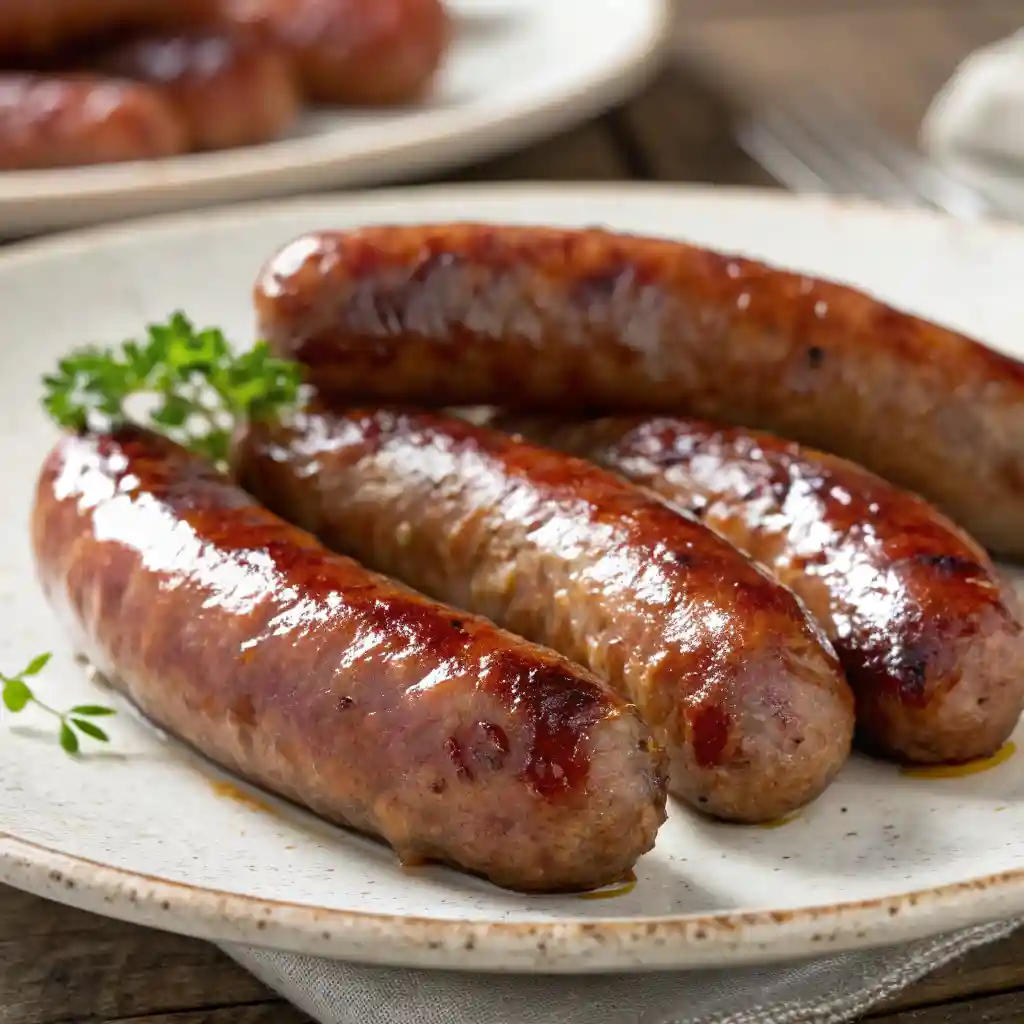This comprehensive guide delves into the world of beef smoked sausage, offering insights into its history, culinary applications, and answering frequently asked questions. Discover delicious recipes, master cooking techniques, and learn the nuances of this flavorful meat, including how to cook the sausage perfectly.
Table of Contents
Introduction to Beef Sausage
What is Beef Sausage?
Beef smoked sausage is a delectable meat product primarily made with beef, often ground beef, which is then seasoned with a variety of spices such as salt, pepper, garlic, and paprika. This mixture is typically encased in a natural casing, giving it its characteristic shape and texture. The “smoked” aspect refers to the preservation and flavoring process where the sausage is exposed to smoke, imparting a unique and savory taste that makes it a popular ingredient in many recipes.
History and Origins of Sausage
The history of smoked sausage stretches back centuries, driven by the need for meat preservation before refrigeration. Early methods involved salting, spicing, and then smoking various meats, including beef and pork, to extend their shelf life and enhance their flavor. Different cultures developed their own unique sausage recipes and smoking techniques, leading to the diverse array of smoked sausage varieties we enjoy today, each with its own distinct seasoning and taste profile.
Differences Between Polish Sausage and Bratwurst
While both Polish sausage and bratwurst are types of smoked sausage, they possess distinct characteristics. Polish sausage, usually made with beef or a mix of beef and pork, is commonly flavored with garlic and black pepper, giving it a strong, rich taste. Bratwurst, on the other hand, is traditionally made with pork and veal, sometimes with beef, and is known for its milder, more nuanced seasoning often including nutmeg and ginger. These differences in ingredients and seasoning contribute to their unique culinary applications and tastes.
Ingredients for Beef Sausage
Essential Ingredients for Beef Sausage

Crafting a delicious beef sausage begins with a foundation of essential ingredients. The primary component is, of course, beef, often ground beef, which provides the bulk and characteristic texture of the sausage. To season this meat effectively, several key ingredients are used:
| Ingredient | Purpose |
| Salt | Flavor enhancement and preservation are crucial in ensuring that beef sausage remains tasty and appealing. |
| Black pepper | Classic, pungent taste |
| Garlic (powdered or minced) | Fundamental aromatic depth |
| Paprika | Warm color and subtle sweetness, rounding out the basic flavor profile |
Optional Ingredients to Enhance Flavor
Beyond the core ingredients, numerous optional additions can significantly elevate the flavor of your beef sausage recipe. To add more heat, you can include red pepper flakes or cayenne pepper. If you desire a smoky undertone without relying solely on the smoking process, liquid smoke can be added sparingly. Other spices like coriander, mustard powder, or even a touch of dextrose can introduce complex layers of flavor. Some recipes might also include a small amount of curing agents like sodium nitrite for improved color and shelf stability, though these are entirely optional and depend on the desired outcome for your smoked beef sausage.
Choosing the Right Cut of Beef
The choice of beef cut is paramount in determining the final taste and texture of your beef smoked sausage. While lean cuts like sirloin can be used, a higher fat content is often desirable for a juicier and more flavorful sausage. Some sausage makers even prefer to incorporate additional beef fat or a small amount of pork fat to ensure the sausage remains plump and moist during the smoking process, contributing to that classic, rich beef sausage experience.
| Beef Cut | Characteristics for Sausage |
|---|---|
| Brisket | Excellent option due to marbled fat |
| Chuck Roast | Good balance of meat and fat |
Beef Sausage Recipes
Classic Beef Sausage Recipe
Creating a classic beef smoked sausage recipe at home allows you to control every ingredient for a truly flavorful experience. This recipe typically involves combining finely or coarsely ground beef with a robust blend of seasonings such as salt, black pepper, garlic powder, and paprika. Some variations might include a touch of dextrose for a subtle sweetness and a curing agent like sodium nitrite for color and preservation. The seasoned beef mixture is then carefully stuffed into a natural casing, prepared for the smoking process that imparts that iconic, deep smoky flavor to the sausage, creating a truly unique frank.
Spicy Beef Sausage Variation
For those who prefer a little heat, a spicy beef sausage variation adds an exciting kick to your culinary repertoire. This recipe builds upon the classic foundation by incorporating chili flakes, cayenne pepper, or even a dash of hot sauce into the ground beef mixture. The amount of spice can be adjusted to your personal preference, ensuring a delightful balance between the rich beef flavor and the fiery notes. Once the seasoned meat is encased, the smoking process will further meld these bold flavors, resulting in a perfectly plump and spicy beef smoked sausage that’s ideal for grilling or pan-frying.
Healthy Beef Sausage Recipe with Vegetables
A healthy beef sausage recipe with vegetables offers a nutritious twist on this beloved meat product, making it a more balanced meal. This approach focuses on using lean ground beef and incorporating finely diced vegetables such as onions, bell peppers, or even spinach directly into the sausage mixture before casing. These vegetables not only add essential vitamins and fiber but also contribute to a juicier and more flavorful sausage. This type of beef sausage can be a great option for a wholesome breakfast sausage or a light dinner, providing all the taste without excessive fat.
Cooking Techniques for Beef Sausage
Best Methods to Smoke Beef Sausage

Mastering the best methods to smoke beef sausage is crucial for achieving that deeply infused, authentic flavor. The smoking process not only flavors the sausage but also cooks it thoroughly, transforming the raw ground beef into a delicious, ready-to-eat product with a beautifully colored exterior and a juicy interior.
| Typical Equipment | Dedicated smoker |
| Temperature range is critical when cooking the sausage to ensure it is safe and delicious. | 175°F to 225°F |
| Common Wood Types | Hickory, Apple, Oak |
Grilling vs. Smoking: Which is Better?
When it comes to cooking beef sausage, the choice between grilling and smoking often depends on the desired outcome and available time. Smoking is superior for achieving a profound, permeating smoky flavor and a tender texture, as the low and slow cooking process allows the fat to render gradually, keeping the sausage juicy. Grilling, while quicker and producing appealing char marks, might not infuse as much smoke flavor, especially if the beef sausage isn’t fully cooked; smoking with hardwood can enhance the flavor. However, grilling is an excellent option for heating up pre-smoked or fully cooked beef sausage, providing a crisp exterior and a satisfying snap to the casing.
Cooking Times and Temperatures
Precise cooking times and temperatures are essential to ensure your beef smoked sausage is both safe and delicious, especially if you’re using monosodium glutamate for flavor enhancement. For raw beef sausage, whether smoking or baking, the internal temperature must reach 160°F to be considered fully cooked. When smoking, this might take several hours at temperatures around 200°F. If grilling or pan-frying pre-cooked beef sausage, the goal is simply to heat it through until a temperature reaches 145°F, ensuring it’s hot and plump.Always use a meat thermometer to check the internal temperature, ensuring the sausage is safe and perfectly cooked with a rich, mouthwatering flavor.
Nutrition and Health Benefits of Beef Sausage
Nutritional Profile of Beef Sausage
Understanding the nutritional profile of beef sausage is essential for incorporating it wisely into any dietary plan. Beef sausage, especially when made with beef, is a good source of protein, which is vital for muscle repair and growth, making it a hearty option for those looking to satisfy their appetite.It also offers important vitamins and minerals, such as iron and B vitamins. However, the fat content can vary significantly depending on the cut of beef used and whether additional beef fat or pork fat is added during preparation, requiring careful trimming for a healthier option. Some varieties of smoked sausage might also contain higher levels of sodium due to the curing and seasoning process, making it important to check the packaging for specific nutritional information.
Health Considerations When Consuming Smoked Sausage
When consuming smoked sausage, several health considerations should be kept in mind to maintain a balanced diet. Due to the curing process, some smoked sausage, particularly those containing sodium nitrite, might be a concern for some individuals. The fat content, while contributing to the juicy flavor, should also be monitored, especially for those on a calorie-restricted or heart-healthy diet. Opting for leaner cuts of beef or choosing a beef sausage recipe that incorporates vegetables can help reduce overall fat content and increase fiber, making it a more dietary-friendly option, especially for gluten-free diets. Moderation is key to enjoying the rich taste without over-consuming fat or sodium.
Balancing Beef Sausage in a Healthy Diet
Balancing beef sausage in a healthy diet involves mindful consumption and smart pairing. To mitigate the higher fat or sodium content, consider combining beef smoked sausage with a variety of fresh vegetables, such as a crisp salad or roasted root vegetables, which add essential fiber and nutrients. Choosing a beef sausage recipe that uses leaner ground beef or is enriched with ingredients like onion or bell peppers can further improve its nutritional value. For breakfast sausage, pairing it with whole grains and fruits instead of additional fatty sides can create a more wholesome meal. Enjoying this flavorful meat in moderation allows for a satisfying culinary experience without compromising dietary goals.

Frequently Asked Questions (FAQs)
How to Store Beef Sausage?
Proper storage is crucial to maintain the freshness and flavor of your beef smoked sausage. Unopened packaging of beef sausage should be stored in the refrigerator, typically lasting for several weeks, as indicated by the “best by” date on the grocery store packaging. Once opened, the beef sausage should be consumed within 3-5 days to ensure optimal taste and safety. Freezing is a great choice for extended storage. Always ensure the sausage is kept in an airtight container or tightly wrapped to prevent freezer burn and maintain its juicy texture and rich flavor.
Can I Freeze Beef Sausage?
Absolutely, beef sausage can be frozen, which is an excellent way to extend its shelf life and prevent waste. To freeze beef sausage, it’s best to wrap individual sausages or smaller portions tightly in plastic wrap or aluminum foil, then place them in an airtight freezer bag. This helps prevent freezer burn, which can affect the taste and texture of the meat. To use, just thaw the beef sausage in the refrigerator overnight. Freezing does not significantly alter the flavor or quality of the fully cooked or raw beef sausage, ensuring it remains flavorful and plump once cooked.
What to Serve with Beef Sausage?
Beef smoked sausage is incredibly versatile and pairs wonderfully with a wide array of side dishes, making it a staple for many meals, and can also be featured in a hearty burger. For a classic BBQ experience, serve it alongside coleslaw, baked beans, and cornbread, or create a delicious sandwich with beef sausage. For a heartier meal, consider mashed potatoes, roasted vegetables like bell peppers and onions, or even a robust pasta dish. If you’re looking for a breakfast sausage option, pair it with scrambled eggs, hash browns, or pancakes. The rich, smoky flavor of the beef sausage complements both savory and slightly sweet accompaniments, offering endless culinary possibilities whether grilled, baked, or pan-fried in a skillet over medium heat.

Easy Beef Sausage Recipe
Method
- Prepare the Beef MixtureCombine finely or coarsely ground beef with a robust blend of seasonings such as salt, black pepper, garlic powder, and paprika. For a spicy variation, incorporate chili flakes, cayenne pepper, or a dash of hot sauce. For a healthy option, include finely diced vegetables such as onions, bell peppers, or spinach.
- Stuff the CasingsCarefully stuff the seasoned beef mixture into natural casings. Ensure the casings are filled evenly to create uniform sausages.
- Smoke the Sausage (Preferred Method)Preheat your dedicated smoker to a temperature range of 175°F to 225°F. Place the beef sausages in the smoker. Smoke for several hours until the internal temperature reaches 160°F. Common wood types for smoking include Hickory, Apple, and Oak.
- Grill or Pan-Fry (for pre-cooked or quick cooking)If grilling or pan-frying pre-cooked beef sausage, heat until hot and plump, aiming for an internal temperature of 145°F. For raw beef sausage on the grill/pan, cook until the internal temperature reaches 160°F. Grilling provides a crisp exterior and appealing char marks.
- ServeServe the beef sausage with your preferred side dishes such as coleslaw, baked beans, cornbread, mashed potatoes, roasted vegetables (bell peppers, onions), or pasta. For breakfast, pair with scrambled eggs, hash browns, or pancakes
- StorageStore unopened beef sausage in the refrigerator for several weeks. Once opened, consume within 3-5 days. For extended storage, freeze individual sausages or smaller portions tightly wrapped in plastic wrap or aluminum foil, then place in an airtight freezer bag. Thaw in the refrigerator overnight before use.
